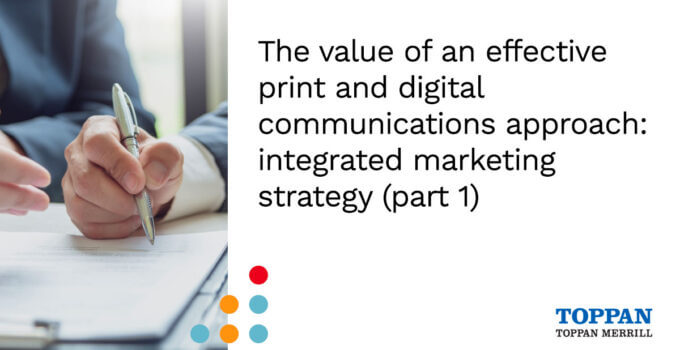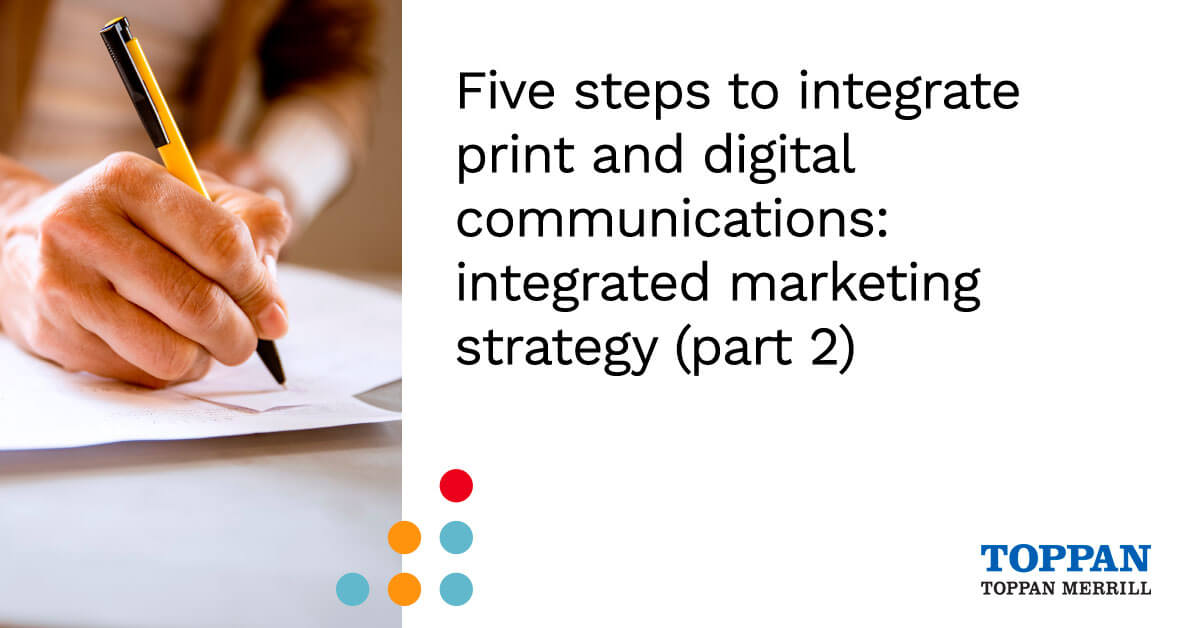In today’s world, digital-first dominates the communication strategies of Firms across the globe. Study after study shows that COVID-19 has accelerated the digitization of customer interaction by several years. In just a few months, the pandemic has transformed the way Firms across industries and geographies do business. Almost overnight, it provided us a sudden look into our future world, one in which digital has become central to every interaction — the primary, sometimes even only — customer-engagement model.
Notwithstanding the rising prevalence of digital communication, print has remained relevant — regardless of its traditional nature. To overlook this vital communication channel means that Firms are missing opportunities to boost their campaign ROI and to connect with customers in a trusted and meaningful way.
Staying relevant in this new environment requires new strategies and practices, where digital and print work together to deliver superior results.
Digital transformation as a powerful lever to unlock hidden value
Digital transformation empowers Firms to unlock potential across sectors and regions, enabling them to scale up effectively, reaching new customers at minimal costs.
In marketing, going digital has had massive consequences. According to Digital Marketing Institute, accurate metrics, combined with interactivity, have created whole new marketing opportunities.
Digital marketing facilitates automation and marketing analytics, allowing Firms to communicate with their customers and leads in ways not possible in physical reality.
Digital technology helped solve the single weakest spot in marketing — the lack of high-quality, actionable data for marketing decisions. Empowered by the wealth of digital data points, Firms can now use marketing analytics to offer a more personalized approach as they can track customer behavior and adjust their marketing efforts according to the collected insights. This creates a superior customer experience that is rapidly becoming a critical competitive differentiator across the industries.
Risks of a digital-only approach
There is no doubt that digital technologies provide vast opportunities for efficiency gains and enhanced customer experience.
In today’s hyper-connected world, Firms can reach and engage with customers in more ways than ever. But when our goal is to drive action, the question opens up — are all marketing channels created equal?
Notwithstanding the rapid proliferation of digital technology across the board, signs are emerging that consumers are approaching a saturation point. Even before COVID-19 hit, digital fatigue was real — and the pandemic only made matters worse.
In response to recent unprecedented events, Firms across the world have relied heavily on digital marketing. With digital technology use at an all-time high, more consumers are also using social media to stay connected with their family, friends, and work.
But as the pandemic dragged on beyond what had been previously expected, consumers have started seeking a break from the many screens they look at each day.
The sheer amount of digital content they are exposed to every day — from 4,000 to 10,000 pieces of advertising — makes consumers seek digital detox to combat the barrage of messages from multiple sources. Overloaded with digital communications, they tune out digital marketing to fend off the digital noise they are exposed to daily.
As the digital landscape has become cluttered, the digital-only approach increasingly fails to make a meaningful impact with online marketing campaigns yielding diminishing returns.
This is where going back to basics offers a solution.
Print still generates customer engagement and drives sales
Against this backdrop, the case for print in marketing is growing stronger. Signs are emerging that it is experiencing a revival — and the latest research backs its effectiveness.
A recent neuromarketing study set out to quantify the relative effectiveness of physical (direct mail) and digital (email and display) advertising media.
Researchers examined the brain imaging indicators that correspond with two key metrics of media effectiveness — ease of understanding and persuasiveness. It turns out that print is easier to understand and more memorable than digital media as it requires 21% less cognitive effort to process. It also elicits a much higher brand recall.
Even more important, direct mail is much more persuasive, having a 20% higher motivation response compared to digital. Its physical nature stimulates the underlying mental processes that drive behavior, which means it is more action-oriented than digital media.
Another neuro research study found that direct mail is much more memorable — it is remembered 35% more than social media and 49% more than email.
The bottom line is: Print has a palpable impact on marketing profitability. It enables engaging, effective campaigns, significantly boosting their ROI. For example, a recent study has found that adding print communication (newspaper ads) increases marketing campaign ROI by as much as 280% for retail and a whopping 570% for finance.
It is increasingly clear that the digital-only approach creates a gap that marketers need to address. With print marketing, Firms can leverage an untapped opportunity to grab and hold customers’ attention in a digitally cluttered world.
When incorporated into an integrated marketing strategy, print marketing can become a powerful differentiator helping Firms stand out from the sea of emails and digital ads to reach and engage their customers in ways never seen before.
Benefits of both worlds: Integrated marketing strategy
Digital communications are often cheaper, but printed communication is still relevant as it offers more engagement. By appearing offline, Firms can cut through the digital fatigue with the help of print marketing.
The key to success in today’s world, where consumers have grown increasingly wary of digital communications, is combining print and digital approaches. Print offers Firms the opportunity to differentiate themselves in a trusted and meaningful way.
Savvy Firms recognize this and supplement their digital marketing campaigns with printed communications that cut through the digital clutter and attract attention and engagement.
The key to success is to choose and use all channels in the most effective way. New technologies are being developed to facilitate print and digital integration and make them both work better together.
But technology is not enough. The whole organization and its resources — from people, money, and processes — need to be aligned to support an effective integrated marketing strategy, one that includes both print and digital campaigns.
Your next steps towards a successful integrated marketing strategy
People are spending more time in the digital environment. But, it is also true that they are increasingly becoming immune to digital marketing efforts when they are online. To top it off, they are also trying to physically remove themselves from digital devices, seeking more and more time away from screens. Digital detox becomes a thing as the online space grows cluttered with an overwhelming amount of information customers are exposed to each day.
The time is ripe for a different marketing approach. An integrated strategy that includes a well-executed combination of digital and print marketing can be a powerful lever that Firms can use to stand out and gain a competitive advantage. To find out how your Firm can bring your print and digital marketing efforts together, be sure to subscribe to our blog to receive part two of our blog series, which will walk you through the five steps to ensure a successful integrated marketing strategy.
How Toppan Merrill can help
Toppan Merrill offers several services, including document creation and management, sales enablement, omnichannel communications, printing services, and more. We deliver best-in-class solutions that help you respond quickly to changes in regulations, client needs and markets.
Learn more about how we can help you with mission-critical content by visiting our website.

